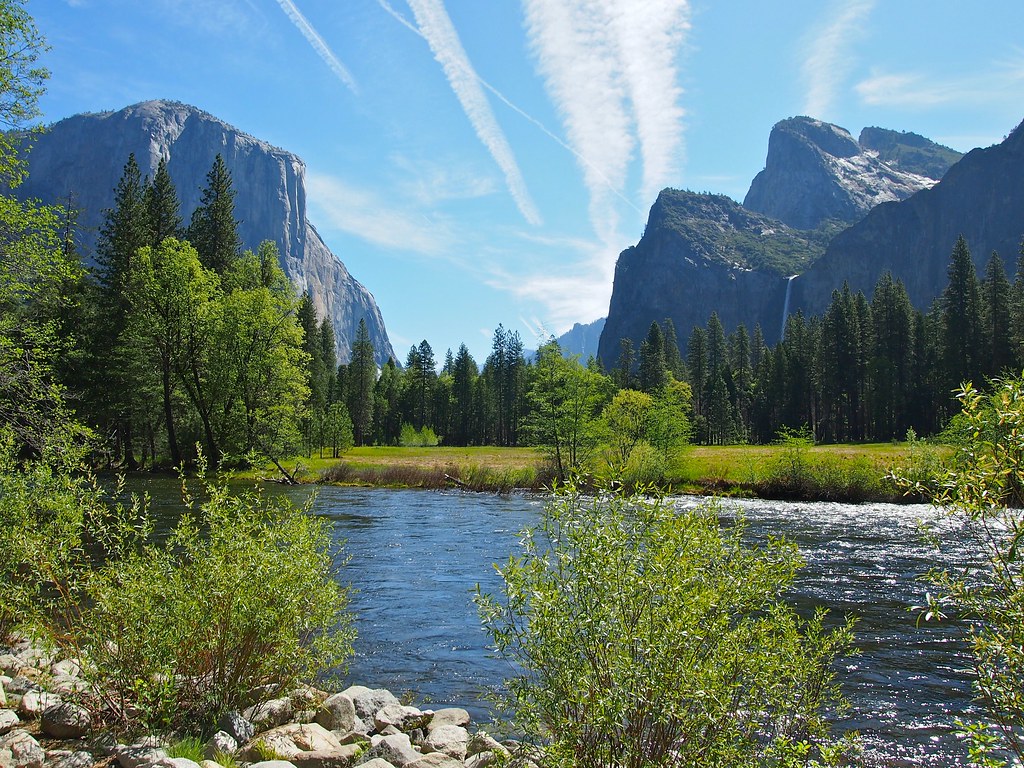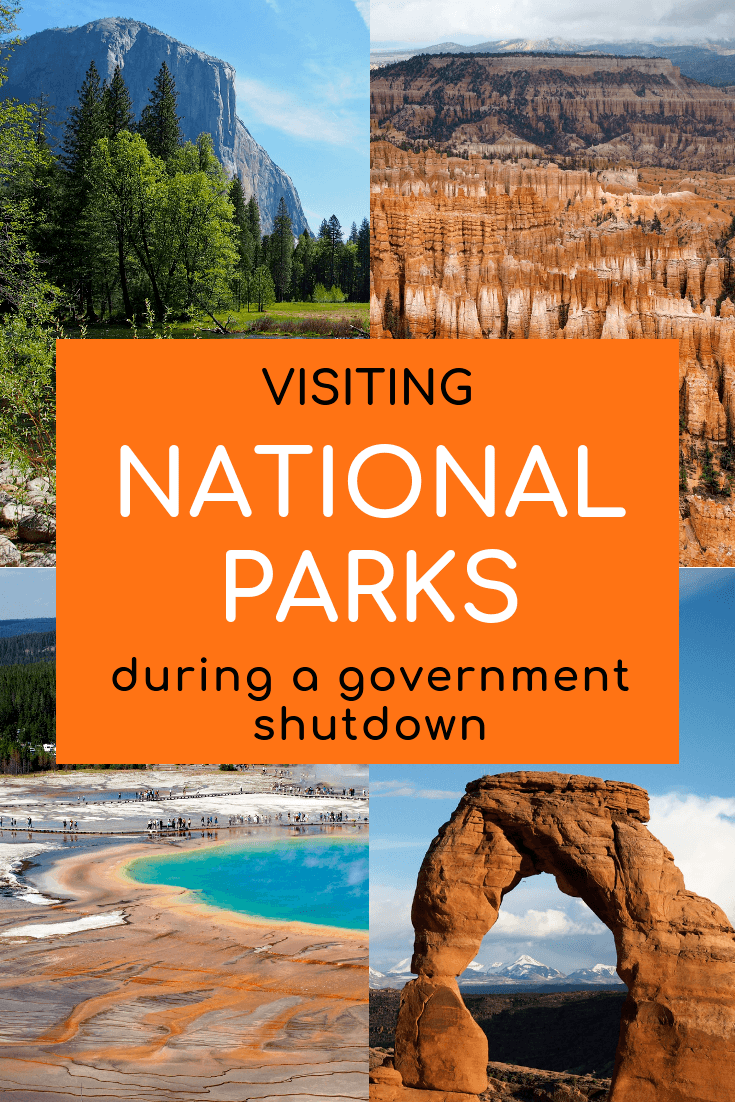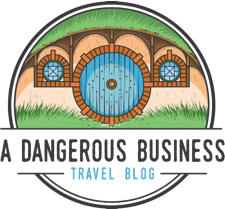As I slowly navigated the icy road leading into Grand Canyon National Park, I found myself feeling uneasy; and it wasn't just because of the slippery road.
I was visiting the Grand Canyon in the first couple of days of 2019. It was supposed to be a fun holiday break trip with a friend who's always dreamed of visiting the Grand Canyon. But our visit unfortunately coincided with a partial government shutdown that was, at that point, going into its second week.

The National Park Service is a federal agency, and is one that is almost always affected when the US government shuts down over budgetary issues.
I knew we could still visit the Grand Canyon during the 2019 shutdown; after backlash over national parks and lands completely closing during a shutdown in October 2013, changes were made to how the National Park Services deals with shutdowns. Most NPS lands now remain technically open to visitors, even when the federal government shuts down.
But just because you can visit a national park during a shutdown doesn't necessarily mean you should*.
*And after the 2018-19 shutdown when ignorant visitors trashed restrooms and destroyed natural resources at some parks, the question has once again been raised about whether parks should remain open during full government shutdowns. If the government shuts down again on October 1, 2023, some of the below details may change! Please check back for updates after October 1.
How a government shutdown can affect your travel plans
My trip to the Southwest and the Grand Canyon was planned before the government shutdown went into effect, and canceling it wasn't really an option.
This is true for most people with trips planned during a shutdown. In many cases, you've already made plans and paid for things – and most travel insurance policies don't recognize a government shutdown as a refundable reason for trip cancelation.

The good news is that most essential travel services are still available during a partial shutdown. A number of air traffic controllers, air marshals, and Transportation Security Administration (TSA) officers are deemed essential and are still expected to report to work – though remember that they aren't being paid to be at work, so make sure you extend a little extra kindness to any you meet.
If you're traveling from abroad, the US still keeps its embassies and consulates open during shutdowns, and travelers can still apply for and receive entry visas.
The actual act of traveling in the United States during a government shutdown isn't severely impacted. But the places you can visit very often are.

What's open and what's closed in a government shutdown
From a tourist perspective, you're probably most concerned with what's open and what's not during the shutdown.
During the 2019 shutdown (and likely any others that might happen in the future), federal buildings and monuments that could be locked up were closed entirely. This included places like the Smithsonian museums, the National Zoo, and some federal monuments.
Basically, if it's an attraction run by the federal government, chances are it'll be closed during a shutdown.
The exception here was national parks.
After backlash over parks being fully closed during a shutdown in 2013, the federal government kept them open(ish) during the 2018-19 shutdown. Unfortunately, this decision was later found to be illegal after an investigation by the Government Accountability Office, so it's unclear what might happen in future shutdowns.

(If you're planning a trip to Washington DC, check out some DC museums you CAN visit during the shutdown.)
Can you visit national parks during a government shutdown?
The short answer is: maybe?
In the 2018-19 shutdown, roads, lookouts, trails, and open-air memorials inside most* of the United States' national parks were still accessible during the government shutdown.
BUT the longer answer is that, while parks were still accessible during the shutdown, they weren't necessarily “open.”

When the government shuts down, national park rangers and employees are furloughed, meaning you won't find many National Park Services operating during a shutdown. Visitor centers will be closed; entrance fees won't be collected; educational programs will be canceled; campsites won't be staffed. And, in many instances, restrooms will be closed and services like trash collection and road maintenance will be suspended.
There will also be fewer emergency/rescue services available, and the NPS won't update its website with important safety information for any of its parks.
In short, you basically visit national parks at your own risk during a shutdown.
(And that's IF they choose to keep park gates open at all; it's unclear if they will in the future.)

*During the 2019 shutdown, some national parks that experience lots of snow closed due to a lack of funds for snow removal. For example, Arches National Park in Utah was completely closed due to snow in January 2019.
When third parties step in
If national parks were to completely close during a shutdown (as they did for the first half of the 2013 shutdown), the National Park Foundation estimated that 715,000 travelers' plans would be affected each day. That's a lot of unhappy travelers.
So, to help combat this, many state governments and third parties have stepped up to fund services at some of the more popular national parks and monuments during shutdowns.

Places where third parties funded services during the 2019 shutdown included:
- Grand Canyon National Park – The state of Arizona funded custodial services to keep restrooms open, continue trash collection, and perform snow removal on trails and sidewalks.
- Zion and Bryce Canyon national parks – The state of Utah funded custodial services and even staffed visitor centers for as long as it could.
- Yellowstone National Park – Yellowstone isn't super accessible during the winter anyway, but private companies paid to keep trails and roads groomed, and to clean park restrooms.
- National Mall – In Washington, DC, private concessions provided restrooms at several spots along the National Mall, and trash collection still happened thanks to volunteers and non-government organizations.
- Statue of Liberty – New York state paid to keep the Statue of Liberty and Ellis Island open.
When I visited the Grand Canyon on January 1 and 2 in 2019, there was definite evidence of the shutdown. No entrance fees were being collected at the gates, and the visitor center was locked.
But most other services were running smoothly. Restrooms were being kept clean, snow removal was happening in the parking lots (I visited right after a snowstorm blew through northern Arizona), park shuttles were running, and all the lodges and restaurants in Grand Canyon Village were open.

This is because Arizona was paying for some services to continue, and others (like the running of lodges and restaurants) are taken care of by private concessions that aren't affected by federal shutdowns.
However, as any shutdown drags on, the money provided by state governments, non-profits, and other entities can only go so far.
How national parks are hurt by a shutdown
As I alluded to at the beginning of this post, I went through a bit of inner turmoil about visiting a national park during the government shutdown.
Sure, it turned out that the Grand Canyon was being taken care of. But the same isn't always true at many other parks.

Most notably, Joshua Tree National Park closed its gates and campgrounds in 2019 because of sanitation issues at the campgrounds and safety issues (both for visitors and the natural environment) in the park – people were cutting down Joshua Trees (!!!!).
At other parks, there were reports of overflowing trash cans, human feces in places human feces isn't supposed to be, and a general disregard of the rules that usually keeps our national parks pristine.
Some national parks had to dip into entrance fee funds to try to clean things up – funds that they usually rely on for other things throughout the year.
One of the big things I fretted over as I visited Grand Canyon National Park was not paying my entrance fee. As car after car rolled through the open gates, I couldn't help thinking about how much money the parks were losing during the shutdown.
And, indeed, the National Parks Conservation Association estimates that the NPS lost $400,000 per day from entrance fee revenue during the last shutdown. PER DAY, people. That's not an insignificant amount of money.

(If you want to ensure the NPS can benefit from your entrance fee, consider purchasing an annual pass to all US national parks during a time when a shutdown isn't happening. These passes cost $80 and are good at any National Park Service-managed site for one year.)
Should you visit a national park during a shutdown?
People tend to take advantage of free entry to many national parks during government shutdowns, and many others (understandably) don't alter their travel plans to avoid visiting them.
But should you be visiting national parks during a shutdown?
There's no clear answer. Some people say no, simply because many visitors don't respect national parks and monuments when there are no park rangers around.
I personally would say that *if* they keep the gates open, then it's okay to visit most national parks during a shutdown – as long as you're committed to visiting responsibly. (If they close the gates, then no, you definitely should not break in to visit.)

How to visit a park responsibly during a government shutdown
If you don't want to cancel your trip to the Grand Canyon or Yosemite or Zion during a government shutdown AND those parks remain open, here are some tips for how to visit national parks responsibly:
- Carry out any and all trash. Even if there are trash receptacles available, consider carrying out anything you bring in. It's not that difficult to stuff an extra reusable bag into your day pack so you can carry out everything you bring in. (And please note that this includes food waste like orange and banana peels, too – those don't belong in the woods and don't break down as quickly as you probably think.)
- If you planned to camp, consider alternative lodging options if possible. If not, please, please, please clean up after yourself (and pack your own toilet paper), and only camp in designated areas.
- Respect signs and stay on the trail. Just because there aren't park rangers around doesn't give you free reign to go wherever you please. Many national parks and monuments exist to protect fragile ecosystems and natural wonders that cannot be replaced. If you see a sign asking you to stay on designated trails, please respect them – and this goes for keeping dogs on leashes, too!
- Follow Leave No Trace principles. Which are basically: be prepared, clean up after yourself, and don't be an asshole.
- Consider donating to the parks. Since the National Park Service doesn't collect park fees during a shutdown, consider making a donation on your own to the National Park Foundation – especially if you visit a national park that would normally charge a fee.
- Consider alternatives to national parks. Lastly, if you have some flexibility in your plans, consider visiting state parks that are close to national parks instead. They're often just as beautiful, but won't be suffering from the government shutdown.
And, for goodness' sake, if a park or monument is closed during a shutdown, DON'T break in. It is not your right to visit a place that is closed or off-limits.

National park alternatives
There are hundreds of national parks and monuments all across the United States – but there are hundreds MORE state parks.
Many state parks are located adjacent or very close to national parks – meaning you can still contribute to the local economy while avoiding adding to the strain many national parks are currently facing.
Some state parks you can visit near popular national parks include:
- Snow Canyon State Park instead of Zion National Park in Utah
- Goblin Valley State Park instead of Bryce Canyon National Park in Utah
- Dead Horse Point State Park instead of Canyonlands National Park in Utah
- Monument Valley Navajo Tribal Park instead of Arches National Park in Utah
- Mount Mitchell State Park instead of Great Smoky Mountain National Park in North Carolina
- Lamoine State Park instead of Acadia National Park in Maine
- Bogachiel State Park instead of Olympic National Park in Washington
- Calaveras Big Trees State Park (for sequoias) instead of Yosemite National Park in California
- Anza-Borrego Desert State Park instead of Joshua Tree National Park in California
- Valley of Fire State Park in Nevada instead of Death Valley National Park in California
- Golden Gate Canyon State Park instead of Rocky Mountain National Park in Colorado
- Big Bend Ranch State Park instead of Big Bend National Park in Texas
- Custer State Park instead of Badlands National Park in South Dakota
- Fakahatchee Strand State Preserve instead of Everglades National Park in Florida
And instead of the Grand Canyon, you could visit Valley of Fire State Park in Nevada, or Red Rock State Park in Arizona, both of which are only a couple hours away.

So, to sum up everything in this post: National parks may still technically be open during a government shutdown (maybe!), but many services won't be available.
You may still be able to visit national parks during a shutdown, but I recommend visiting carefully (and responsibly!), or, better yet, visiting state parks instead if you can.
Want to read more about national parks?
Here are some posts on some of my favorite national parks and monuments for further reading:
- The Mighty 5: Utah’s Stunning National Parks
- 5 Things to Do in Zion National Park That Don’t Involve Hiking
- Tips for Visiting Yosemite National Park in One Day
- Yes, You Can Visit the Grand Canyon in Winter
- Yellowstone National Park: What to Do and See in 2 Days
- 10 Awesome Things to Do in New River Gorge National Park
- Everything You Need to Know About Visiting White Sands National Park
- Badlands National Park: Underrated and Awesome
- Cuyahoga Valley: Ohio’s Only National Park
Have you visited a national park during the government shutdown? Do you have any other questions about visiting?
Pin it for later:


Amanda Williams is the award-winning blogger behind A Dangerous Business Travel Blog. She has traveled to more than 60 countries on 6 continents from her home base in Ohio, specializing in experiential and thoughtful travel through the US, Europe, and rest of the world. Amanda only shares tips based on her personal experiences and places she's actually traveled!










Such a wonderful post about an important issue. I had plans to visit Joshua Tree that happened to be on the first day of the government shut down. I still went and proudly hung my America the Beautiful pass on my rear view mirror. As an American, I love our national parks. The fact that the US government has set aside parcels of land for everyone to enjoy for generations is a huge gift. As the shutdown drags on, every day I become more depressed about how visitors are treating the parks. I’ve never understood how you could go to a place to marvel at its beauty only to work to destroy it. As the parks belong to us all, I felt that the parks should be open and that we could be responsible stewards to protect the land. I mean, how hard is it to pack out your trash? But now, after all the reports, I think all parks should be closed. They were made parks to protect the land and ecosystems. By keeping them open, we’ve failed on our protection.
I agree – I initially thought it was a positive thing that parks were still going to be accessible during the shutdown. But now I’m not so sure. It sucks that a few bad eggs can ruin things for everyone else. You’re absolutely right that it shouldn’t be difficult to be conscientious and pick up your own trash, stay on trails, etc.
Thanks for doing all the research and sharing information for travelers to our national parks and our heritage as a nation. We visited Joshua tree on Christmas and it was great but I’m hearing such disturbing news now. I hope third party and volunteer interventions will save our parks. If every visitor does their part it will go a long way in preserving.
Volunteer groups have been doing a lot of great work looking after the parks and other areas as much as possible. And I hope I’m doing my part by just bringing awareness to this topic – a lot of times people make poor choices and do harm simply because they haven’t been properly educated.
I’m mind-boggled by this whole shutdown business. I’ve never heard of a thing like that – at least not in my own country. I think this is a great post to help travellers along with this shutdown, as I think most people will be baffled by it especially if they have planned a trip to the US during that time.
Yeah, it’s super confusing; even people here in the US don’t completely understand what’s happening (sadly Congress doesn’t even really understand how these shutdowns affect people). Definitely hoping people find this helpful!
It’s so sad that the government shut down is affecting the parks, if only nature could be free of petty politics :/ Thanks for this useful information, I’m sure a lot of people are asking themselves these questions!
I certainly hope this helps some people out – during this shutdown, and during future ones (because I’m sure this won’t be the last).
Crazy times. I heard about the trees being chopped down – what on earth makes people think this is ok? I’m glad you still got to make your trip as that would have been so disappointing if the park had been closed. Good tips about how to be responsible too. Just wish everyone would follow them.
People really do baffle me sometimes! The worst part is that those people probably won’t be caught. The only consolation is that *most* people are still visiting the parks responsibly. But of course it’s the few who aren’t that will ruin it for everyone else.
Excellent post, so much to think about. Also I had no idea it snowed at the Grand Canyon that frosty picture is fantastic
Thanks for reading! (And stay tuned – once the parks are back open, I’ll be writing about the Grand Canyon in the snow!)
This whole thing is such a disaster. It’s amazing just how many people it’s affecting in so many ways!
I know. I didn’t even get into all the other people it’s affecting because the list is just so long!
This definitely makes you think about how the government could better go about things. I do wonder if giving them to the states to control would be a better solution. There seems to be no reason for a complete shutdown of them if they can collect park fees and at least make some money that way. I love our National Parks, they’re a showcase of some of the best places in our country and shouldn’t be bothered by stupid politics 🙁 Hopefully the majority of visitors will be respectful! These are all really good points you made, and good alternatives too for state parks!
It’s such a tricky things to balance. Previously the parks did completely shut down, but received so much backlash about it. Now that they’re partially open, new issues are coming to light. I agree that I wish they could still collect entrance fees from the people who are still visiting, but I also would not expect Rangers to work without getting paid themselves. I’ll be interested to see if shutdown procedures change again once this one is over, though.
This is obviously so topical and very important right now. I really appreciate this post as I am having such a hard time wrapping my mind around the abuse people have bestowed on the parks. It makes me so sad. And you know our president doesn’t care at all. I wonder how the parks will recuperate once they reopen and have to clean up all the damage without any money from entrance fees.
It makes me so angry and sad that some people have shown such a disregard for our beautiful national parks. BUT the good news is that there are far more people being good visitors than bad ones; just have to keep reminding myself of that.
I was so glad to come across this post! It is so sad how the government shutdown has affected national parks and those who visit them. I was happy to read your tips about visiting responsibly and your recommendation about state parks.
The US has some really amazing state parks that a lot of people don’t know about. I like to combine visits to national and state parks, and right now would be an excellent time to do that.
This is super helpful! I was wondering if I could visit national parks during the shut down. Sounds like I can. Incredibly frustrating time in the US. Thanks for clearing up some things for me!
Yup, you should still be able to visit most of them – but definitely keep some of these tips in mind!
Great post. I struggled with some of these feelings today visiting Shenandoah National Park, about an hour from my home. We made sure to 1) plan for no bathrooms, 2) not leave any trash (even in trash cans), and 3) I have an annual membership, so I’ve paid for entry for the whole year regardless of a ranger being there. I am glad to report that the park was in a pretty good shape minus branches/leaves in some of the parking lot roadways which was mostly due to wind anyways. I do hope this shutdown ends soon though!
Good to hear that the park is in good shape! The same is true here at my local park (Cuyahoga Valley), but I know others have been struggling.
And duh – just read the final points of your post that calls out folks to donate (duh – always finish reading before commenting -I’m a professional fundraiser and sometimes I just can’t help myself!). Feel free to disregard my previous comment. Still love your posts – I am fairly new to the blog and have loved reading through all the different places you have visited! 🙂
Haha no worries! That’s definitely a tip I made sure to include.
Amanda, great post and thank you for sharing. A great way to “Pay” that entrance fee is to make a gift to the National Parks Foundation to help during this time.
“By supporting the Parks Restoration Fund, your donations will go to the parks that need help the most. The National Park Foundation will be able to work across the National Park Service and our park partners to assess needs and provide clean up efforts once the parks are back open.” Here is the link: https://www.nationalparks.org/connect/blog/national-parks-during-government-shutdown
Yes, this is definitely a must! I made a donation myself after visiting the Grand Canyon. 🙂
Fantastic post, Amanda. I’ve been following some of the news with very furrowed eyebrows. I don’t think you needed to worry about whether to visit, because YOU are a responsible traveller. Unfortunately so many people are not, and I’m really worried that it could have a devastating impact on what is – to me – one of the best things about the US. I’m shocked that NPS are losing so much money over this too – not that Trump will actually care about that. As long as he gets his wall, hey?
I’m definitely worried, too. And the parks that are dipping into their fee funds to clean up worry me, too, because it probably means they’ll have to cut back somewhere else later this year. It’s just a terrible situation all around. But since I know people are going to continue visiting during the shutdown, I thought maybe I could help provide some tips on how to do it responsibly.